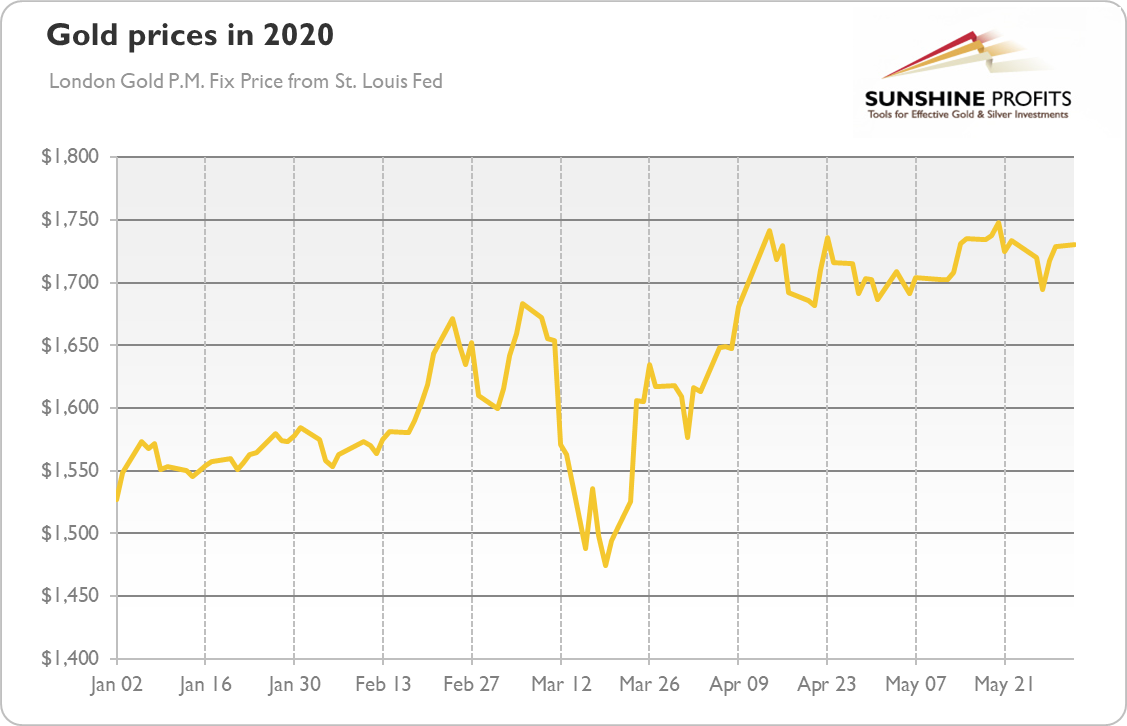Gold is expected to serve as a safe-haven asset. But during the depths of the coronavirus crisis, many people couldn’t find physical gold, as there was a bullion shortage at dealerships. And these lucky individuals who managed to obtain bullion had to pay high premiums. What kind of safe haven is one that people can’t find? And does the price divergence between physical and paper gold show there has been price manipulation in the latter market? Let’s analyze what really happened in the bullion market during the coronavirus crisis.
First of all, gold benefitted from safe haven demand. Since the dawn of civilization, people turn to gold to protect their savings when they are worried about the future. Gold was demonetized in 1971 when President Nixon closed the gold window, ending the gold standard, but gold never lost its position as a store of value. It should not be surprising, as gold was used as money for thousands of years and it has no counterparty risk.
However, that high demand outpaced supply. The coronavirus crisis is both a negative demand and supply shock. Many supply chains were broken. Quarantine, labor absenteeism, travel limitations and other measures undertaken to prevent the spread of the coronavirus disrupted the normal, smooth functioning of the economic engine. And it applies to the mints and refiners, which simply could not work at full capacity. The bullion coin you see in retail stores is a highly sophisticated product that had to be refined, minted, and transported, which can be logistically challenging even in normal times, but it became really difficult during the Great Lockdown.
No evidence of manipulation
This is the reason behind the supply shortage and high premiums. They do not necessarily prove manipulation in the paper gold market. Rather, refineries and mints stopped operating, or capped production, because of the collapse in global travel and shutdowns of local economies. Remember that three important gold retailers – Valcambi, Pamp and Argor-Heraeus – are all based in the Swiss region of Ticino, near the border with Italy, that was quickly shut down at the beginning of the current pandemic.
Investors should remember two things here. First, there is always a certain premium on retail gold, as bullion dealers live off these margins. One cannot have “spot gold”, so if somebody wants to own physical gold, he or she has to pay a premium. After all, small and beautiful bullion coins or bars add some value and there are costs involved in producing them. Yes, during the coronavirus crisis these premiums soared, sometimes to 10-15%, or even more, over spot prices. But the havoc was unique: exploding demand and disrupted production and distribution chain at the same time.
Second, the markets are not homogenous, but heterogeneous – they are many segments in each market. Just as there is no single labor market, but many labor markets (one for IT specialists, another for waiters, etc.), there is no single gold market. So, prices in these markets may differ, which is pretty normal (you don’t expect that the salary of IT specialists will be equal to waiters’ pay, do you?). After all, the LBMA Gold Price is a snapshot of gold prices quoted by traders in the London OTC spot market for wholesale transactions (and spot price might be even something else, as it is derived from the futures prices quoted on COMEX), while the price offered by bullion dealers is the market price of physical bullion in retail trade.
Premiums for profit
Hence, there might be plenty of gold in a big trading hub like London, as there might be more sellers in the institutional market during the asset selloffs. The big ETFs and central banks do not buy gold at local bullion shops – they buy large gold bars by the truckload. This is why the size of different products is an important reason for the price discrepancy. Such large gold bars are beyond the reach of regular people, who prefer kilobars, one ounce bars and coins, or even smaller products. So they have to pay premium for the possibility to get gold products suitable for their shallow pockets.
Summing up, the bullion shortage and high premiums in the retail market do not prove manipulation in the gold market. They result from market segmentation and supply disruption, together with the explosion in demand for retail gold. But these shortages and high premiums do not have to impact the gold spot price, which is shaped in different segments of the gold market and by different factors. This is why London gold prices could go down during the stock market selloff, as the chart below shows, simultaneously with gold shortages in the retail market.

To be clear, it doesn’t mean that the price of gold will not go up. We actually consider gold’s fundamentals to be bullish. But if gold prices appreciate, they will not do it because of the bullion boom in the retail market, which is a small fraction of the whole gold market, but because of stronger fundamentals and better sentiment among bigger players.
